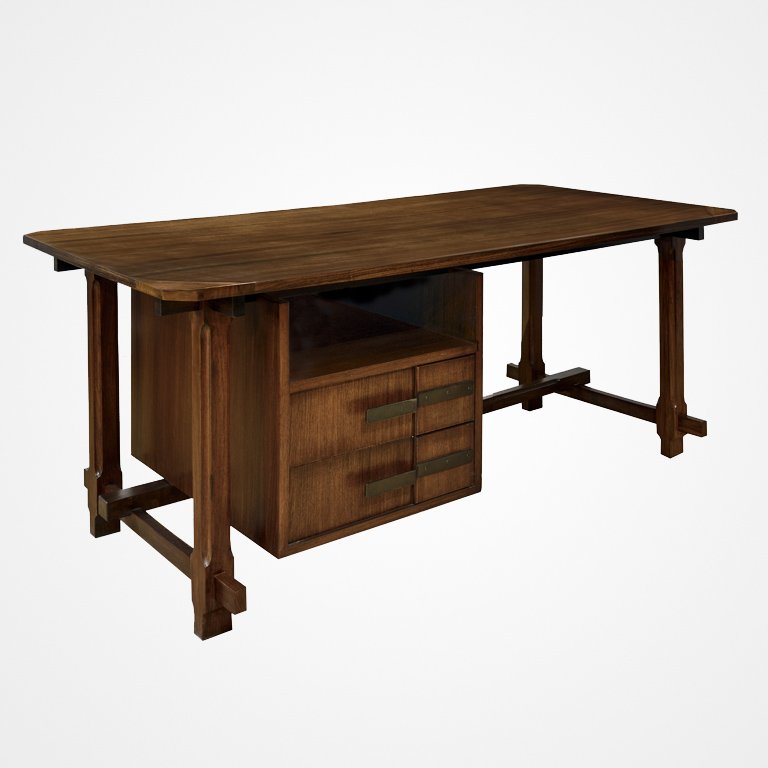Design books and magazine articles on the development of Italian Modernism and post war construction continuously champion the vital role played by Italy’s architects and larger manufacturers. As a result, the names of Ponti, Mollino, Albini, Ulrich, Mangiarotti, Frattini, Parisi, Sottsass, Scarpa, Cassina, Gavina are all very well known. Missing from the discourse however, are the many small producers, with whom architects collaborated to create the body of work which is now called Italian Moderism.
Commenting on what he saw at the 1951 Triennale, american architect, Dorwin Teague saw Italy’s craftsmanship as its greatest resource. These fine artisans were not the mere executors of the architects’ visions. Their knowledge of traditional craft and forms played an influential and important role in shaping the very look of Italian design.
Just an hour north of Milan is the region of Brianza, a furniture-making area established in the 18th century. Andrea Branzi called the region of Brianza the historic cradle of Italian design. By the 1950’s, one third of the furniture made in Italy was produced in Brianza. In 1957, the city of Cantù alone had over seven hundred furniture manufacturers. Most of these firms were family owned and had less than ten employees. With the support of the government, trade associations, and a school for furniture making, a plethora of small furniture shops operated in more than twenty towns in the region. The innovative firm of Cassina in Meda started out as one of these small, family-owned businesses.

Between World War I and World War II Italian Rationalist architecture emerged. One of the most prominent rationalist buildings, the Casa del Fascio was designed by Guiseppe Terragni and built in Brianza in the center of the ancient town of Como between 1932 and 1936. It was initially the local outpost of Mussolini’s Fascist party. Other rationalist architects built housing, post offices, schools and local Fascist buildings in other localities. These were some of Italy’s first modernist buildings. Their design was initially perceived in the school of the newly emerging northern European International Style. Subsequent investigations show them to have plans and aspects of Italian vernacular architecture and of being a particularly Italian take on International Style architecture.
Post-World War II reconstruction efforts focused on the established furniture industry. It was thought that modernization would be key. The small shops had been making furniture that was best described as Neo-Baroque and the industry was falling behind Germany and Scandinavia in the marketplace. There was an additional hurdle, too. The Fascist movement that propelled modern rationalist architecture was now despised.
Proximity to Milan and its important architectural school Politecnico di Milano proved key in the development of Italian modern design. Architects had already been coming to Brianza to have furniture made and Milan was the center of the design industry.
Ponti and other important architects helped to move the industry toward modernization. Ever energetic, Ponti worked with smaller manufacturers to create modern designs that retained Italian artisanal traditions. For instance, he worked with the Manifattura Isa firm in Busto Arsizio as did other important artists. This primed the textile manufacturer for a prominent position in modern Italian design.
As editor of Domus from 1947 onward, Ponti championed crafts and encouraged architects, tradesmen, and artists to work together toward a modernism that included traditional arts. Furniture workshops focused on the growing Italian home market for modernism in the early 1950’s by advancing artisinal traditions in a fresh way. The emerging architects working with skilled craftsmen were trying to define themselves at the same moment that the country needed a new identity.
In 1955 the first Concorso Internazionale del Mobile di Cantù was held. The purpose of this juried international furniture fair and competition was to rebrand Brianza as a modern international furniture producing region. Held in Cantù, the cover graphic of the Concorso, a bold C clamp (a nod to the artisans work), was created by Bruno Munari. The jury for the competition included Gio Ponti, Alvar Aalto, Romano Barocchi, Carlo De Carli, and Finn Juhl. But the consistent showcasing of the architects contribution without showcasing producers has left us with very little knowledge of the firms and personalities who collaborated to create Italian modern design.
My interest in Brianza developed naturally. I’ve been buying furniture in the region for well over a decade. Originally schooled in 18th and 19th century American furniture, I’ve developed sensibilities for construction, scale and design. At one point I was privileged to own a spectacular double dresser designed by Paolo Buffa which was made by Marelli and Collico of Cantù. My restorer, a Paris-trained ebeniste, remarked that the quality of this piece rivaled pieces he had worked on credited to the master french designer, Emile-Jacques Rhulmann. It confirmed what I already knew: furniture from this region was as good as anything being made at the time. My hope is that as time goes on more information will become available about the many skilled artisan/workshops operating in this important region.

Pavia, Italy, c. 1955


